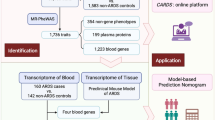Abstract
One hypothesis of the pathogenesis of biliary atresia (BA) is a virus-induced and immune-mediated injury to bile duct cells as mimicked in the rotavirus-induced murine model. This theory is supported by studies showing a predominant T helper cell response type 1-like phenotype of inflammation with increased interferon gamma-induced chemokines in the liver of humans and mice suffering from BA. Recent gene expression profiling studies using microarray analysis showed the induction of a proinflammatory state in human liver specimens with high analogies in extrahepatic biliary tissue of BA mice. The aim of the present study was a microarray analysis of gene expression in the liver of Balb/c mice, comparing infected mice that show the phenotype of BA versus infected mice without symptoms, thus trying to elucidate genes that are not related to the viral origin of this model, but to the specific pathogenesis of the clinical picture of BA. Fifteen μg of RNA, each of three BA-positive and three BA-negative mice, were pooled and comparatively hybridized to spotted cDNA microarrays containing 250 key genes with high relevance to immunological settings. We identified the 40 genes most differentially expressed in mice with and without BA. The majority of genes with higher expression in BA-positive mice encoded proinflammatory cytokines involved in the Th1 pathway, such as CCL2, CCL5, CCR5, CXCL10, CCL2, IL1F5 and in apoptosis, such as DDR3 and granzyme A and B. In this initial study of the molecular characterization of our RRV-induced BA mouse model system, we also found potential novel candidates important to BA etiology, such as growth hormone receptor and insulin-like growth factor. Of particular interest, very low expression of TIMD2 was observed in BA-positive mice. TIMD2 plays a critical role in the regulation of a Th2-type response through the inhibition of IFN gamma.


Similar content being viewed by others
References
Petersen C (2005) Pathogenesis and treatment opportunities for biliary atresia. Clin Liver Dis (in press)
Schreiber RA, Kleinman RE (2002) Biliary atresia. J Pediatr Gastroenterol Nutr 35:11–16
Mack CL, Tucker RM, Sokol RJ, Karrer FM, Kotzin BL, Whitington PF, Miller SD.(2004) Biliary atresia is associated with CD4+ Th1 cell-mediated portal tract inflammation. Pediatr Res. 56:79–87
Riepenhoff-Talty M, Schaekel K, Clark H, Mueller W, Uhnoo I, Rossi T, Fisher J, Ogra PL (1993) Group A rotaviruses produce extrahepatic biliary obstruction in orally inoculated newborn mice. Pediatr Res 33:394–399
Petersen C, Biermanns D, Kuske M, Schakel K, Meyer-Junghanel L, Mildenberger H (1997) New aspects in a murine model for extrahepatic biliary atresia. J Pediatr Surg 32:1190–1195
Czech-Schmidt G, Verhagen W, Szavay P, Leonhardt J, Petersen C (2001) Immunological gap in the infectious animal model for biliary atresia. J Surg Res 101:62–67
Chan R, Tan CL, Czech-Schmidt G, Petersen C (2005) Computerized three-dimensional study of a rotavirus model of biliary atresia: comparison with human biliary atresia. Pediatr Surg Int 21:615–620
Shivakumar P, Campbell KM, Sabla GE, Miethke A, Tiao G, McNeal MM, Ward RL, Bezerra JA (2004) Obstruction of extrahepatic bile ducts by lymphocytes is regulated by IFN-gamma in experimental biliary atresia. J Clin Invest 114(3):322–329
Bezerra JA, Tiao G, Ryckman FC, Alonso M, Sabla GE, Shneider B, Sokol RJ, Aronow BJ (2002) Genetic induction of proinflammatory immunity in children with biliary atresia. Lancet 360:1653–1659
Carvalho E, Liu C, Shivakumar P, Sabla G, Aronow B, Bezerra J (2005) Analysis of the biliary transcriptome in experimental biliary atresia. Gastroenterol 129:713–17
Bosio A, Knorr C, Janssen U, Gebel S, Haussmann HJ, Muller T (2002) Kinetics of gene expression profiling in Swiss 3T3 cells exposed to aqueous extracts of cigarette smoke. Carcinogenesis 23:741–748
Cario G, Stanulla M, Fine BM, Teuffel O, Neuhoff NV, Schrauder A, Flohr T, Schafer BW, Bartram CR, Welte K, Schlegelberger B, Schrappe M. (2005). Distinct gene expression profiles determine molecular treatment response in childhood acute lymphoblastic leukemia. Blood 105:821–826
Petersen C, Grasshoff S, Luciano L (1998) Diverse morphology of biliary atresia in an animal model. J Hepatol. 28:603–607
Mack CL, Tucker RM, Sokol RJ, Kotzin BL (2005) Armed CD4+ Th1 effector cells and activated macrophages participate in bile duct injury in murine biliary atresia. Clin Immunol. 115(2):200–209
Carroll M (2004) The complement system in regulation of adaptive immunity. Nature Immunology 5:981–986
Ajuebor MN, Hogaboam CM, Proudfoot AI, Swain MG (2004) CCL3/MIP-1α is proinflammatory in murine T cell-mediated hepatitis by recruiting CCR1-expressing CD4+ T cells to the liver. Eur J Immunol 34:2907–2918
Chakravarti S, Sabatos CA, Xiao S, Illes Z, Cha EK, Sobel RA, Zheng X, Strom T, Kuchroo V (2005) Tim-2 regulates T helper type 2 responses and autoimmunity. J Ex Med 202:437–444
Koniaris LG, Zimmers-Koniaris T, Hsiao EC, Chavin K, Sitzmann JV, Farber JM (2001) Cytokine-responsive gene-2/IFN-inducible protein-10 expression in multiple models of liver and bile duct injury suggests a role in tissue regeneration. J Immunol 167:399–406
Yoshida S, Nio M, Hayashi Y, Ohi R, Kawamura I, Goto T (2003) Serum insulinlike growth factor-1 in biliary atresia. J Ped Surg 38: 211–215
Held MA, Cosme-Blanco W, Difedele LM, Bonkowski EL, Menon RK, Denson LA (2004) Alterations in growth hormone receptor abundance regulate growth hormone signaling in murine obstructive cholestasis. Am J Physiol Gastrointest Liver Physiol 288:986–993
Acknowledgements
The authors would like to thank Ms Birgit Teichmann for technical assistance and Ms Clare Boerner for revising the text. This work was supported by a grant (HiLFI) from the Hannover Medical School, Germany.
Author information
Authors and Affiliations
Corresponding author
Rights and permissions
About this article
Cite this article
Leonhardt, J., Stanulla, M., von Wasielewski, R. et al. Gene expression profile of the infective murine model for biliary atresia. Ped Surgery Int 22, 84–89 (2006). https://doi.org/10.1007/s00383-005-1589-0
Published:
Issue Date:
DOI: https://doi.org/10.1007/s00383-005-1589-0




